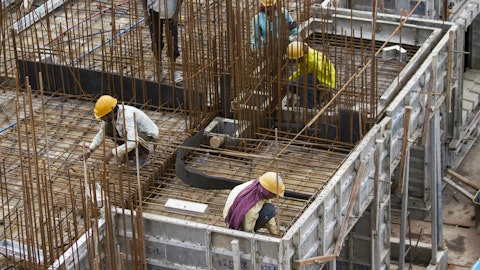Jon Jaffe: I just want to clarify, Steve, on what I said about construction costs. As I noted, we’re currently working closely with our trade and adjusting contracted pricing. That’s what I was referencing in terms of will start flowing through in the second half of the second quarter. The biggest needle mover is lumber which moved down throughout the year, and we will see a benefit of that throughout the entire second quarter.
Stephen Kim: Got you. Okay. That is helpful, Jon. So, in other words, you’re not talking about deliveries in the back half of 2Q with that lower contracted pricing. That’s going to be on stuff you’re sort of starting in the back half of 2Q, I guess.
Jon Jaffe: No, starting now and through quarter and even on some open commitments on homes already started. It’s just that we’ll see the first benefits of those renegotiated prices with trade starting to happen in the latter part of the second quarter, and we will see the full — the benefit throughout the full quarter of lumber reductions that started happening in the summer of ’22.
Stephen Kim: Okay. That’s helpful. I appreciate that. Second question is on your owned lot count. I know you talked a lot about the ratio in years and all that. But your actual number of owned lots declined for the third straight quarter, and it’s down almost 20% from 1Q. And so, I’m wondering, can you help us anticipate how much the actual owned lot count might fall over the next few quarters if market conditions stay challenging and conversely, what kind of market conditions would you need to see for your owned lot count to start rising again?
Rick Beckwitt: Diane, do you want to start that one off?
Diane Bessette: Yes. I mean, Steve, the way I look at it, I think that it’s a positive direction that our owned — home site count has been going down. The desire is to always protect the balance sheet and reduce risk. So, the growth really comes from controlling as much as we can and keeping our owned at a much lower level. But the owned home sites really should be primarily finished home sites where we’re going to put a shovel on the ground pretty quickly. So, I’m not bothered by the reduction of owned. The goal is to keep that as low as possible and keep growing the controlled percentage.
Rick Beckwitt: Well, and I think that basically, if you think about what we’re doing strategically, really building the pipeline between our land bankers, our land bank programming and the execution strategy embedded in our volume-based programming. And that’s just going to continue to build confidence. I think that you’ll see our owned home site count continued to moderate and be right sized relative to the business to be able to adequately provide for either stable delivery levels or growth levels as we choose. But that confidence that we’re building and that pipeline I think is really value-add for the future.
Stephen Kim: Great. Yes, I didn’t mean to imply that. I thought that that was a bad thing, Diane. I certainly agree with you. It’s a good thing.
Rick Beckwitt: Very good. It’s good, and it’s getting better.
Diane Bessette: Yes.
Operator: Next, we’ll go to Susan Maklari from Goldman Sachs. Please go ahead.
Susan Maklari: My first question is thinking about the sales pace, would you actually maintain ahead of your historical normal level in the last quarter, despite everything that’s going on, on the ground. And assuming that that does kind of tie to this broader strategy that you have around, inventory controls and cash generation, can you talk to how we should be thinking about the sales pace for next year? The ability to hold it perhaps elevated even as we do continue to move through this environment and what that will mean for the level of cash that you can generate in 2023?
Rick Beckwitt: So, looking at our sales pace for last quarter as well as our go-forward sales pace, we’re going to keep — as Stuart said, we’re going to keep the machine going and feel that from an overhead and operational standpoint we get greater leverage by keeping that sales active. We know it’s above where we were in 2019 from a pace standpoint and our focus is to keep and maintain that pace as we move forward into 2023.
Stuart Miller: I think you can expect a lot of consistency. I probably haven’t spent enough time talking about our dynamic pricing model, but it is really at the core of how we’re running our business, and we’re doing it on a day-by-day basis, focusing on how do we get the right pricing for the customer base for today’s affordability to maintain that sales pace. I think you’re going to continue to see us working hard in that direction. As I noted, it has the ancillary business of informing our land banking pipeline, but the dependability they expected is the dependability they’ll get. And we’re moving through our pipeline of higher-priced land that was priced or bought to yesterday’s pricing, and we’ll be bringing in land that is more appropriately priced to current market conditions. All of this kind of works synergistically to really inform us to keep that volume and that sales pace consistent.
Jon Jaffe: I would just add and remind you that our strategy has been and remains matching sales to our start pace, and we have a very steady start pace that will inform our sales pace as we move forward. That ties directly into the dynamic pricing model that as a tool our operators use to do exactly that.





